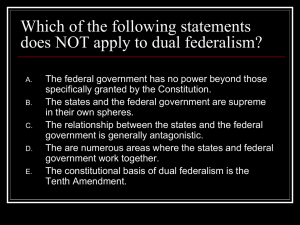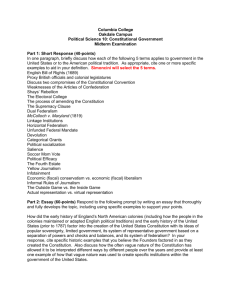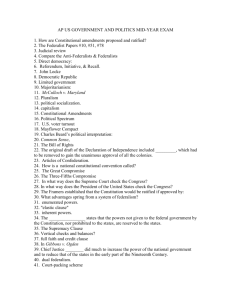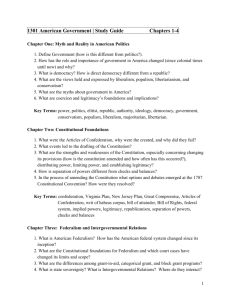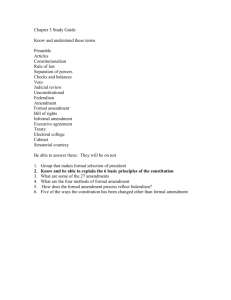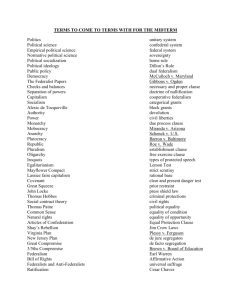The Founding & Constitution
advertisement
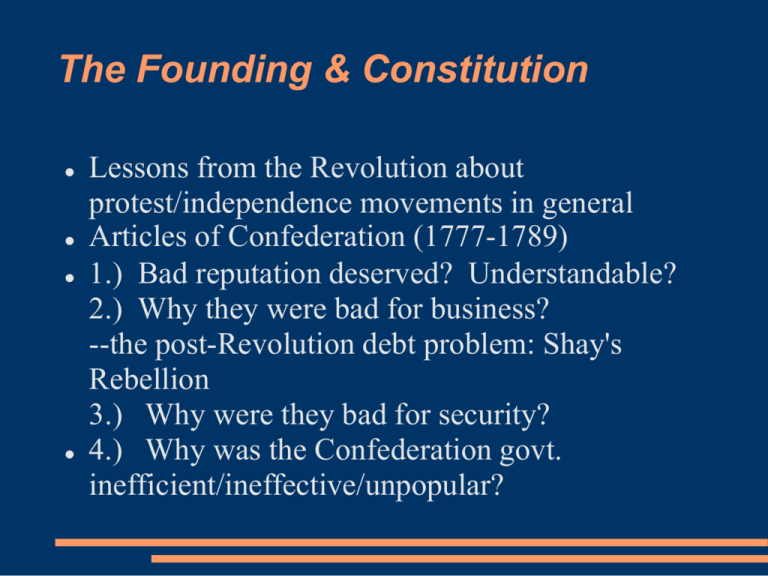
The Founding & Constitution Lessons from the Revolution about protest/independence movements in general Articles of Confederation (1777-1789) 1.) Bad reputation deserved? Understandable? 2.) Why they were bad for business? --the post-Revolution debt problem: Shay's Rebellion 3.) Why were they bad for security? 4.) Why was the Confederation govt. inefficient/ineffective/unpopular? Constitution Achieving 4 main objectives of Convention 1.) Settling questions of representation ---why representation was so impt. ---the Great Compromise & the 3/5ths Compromise ---reasons for bicameralism other than the Great Compromise 2.) Enhancing government power, while reconciling majority rule with minority/individual rights ---Multilayered protection for rights: separation of powers, checks & balances, federalism, and an “extended republic” (Fed. 10) Constitution 3.) Making the US better for business 4.) Increasing legitimacy of US government a.) GW's role b.) Closer link to the public (esp. House) c.) Constitution was a procedural but not a policy document, difficult but not impossible to amend Constitution THINGS PEOPLE ARE SURPRISED TO LEARN ARE (or ARE NOT) in CONSTITUTION 1.) No term limits for anybody (not even President) 2.) Senate's original mode of election 3.) Ambiguity about Electoral College, no WTA 4.) Runner-up becomes VP 5.) Bill of Rights not in original text---but there are some restrictions on Congress 6.) States guaranteed republican form of govt. Constitution 7.) Where's all men are created equal? Where's God? Where's the size of the Supreme Court? Where's judicial review? Where are the other federal courts? Where are the parties? 8.) Congress can restrict SC's jurisdiction 9.) Census mandated in Constitution 10.) Immunity for members of Congress 11.) Congress could restrict importation of slaves after 1808 12.) Never-used method of proposing and ratifying amendments 13.) Complete presidential oath of office is in there Constitution 1.) Ratification method designed to make success more likely (technically illegal) 2.) What successful Amendments have been about 3.) Supreme Court as informal amender Federalism Definition: includes the concept of dual sovereignty Federalism is somewhere between a “unitary system” and a “confederation” Current examples of unitary, confederal, and federal systems: what kinds of countries are good candidates for federalism? Federalism is consistent with two major themes of Constitutional Convention: pragmatic compromise, and multilayered protection of individual and minority rights Federalism Vertical (as oppposed to horizontal) separation of powers, conducive to “forum shopping” Key Constitutional provisions re federalism---supremacy clause --10th Amendment --Article IV provisions, including “full faith and credit” and “privileges and immunities” --Commerce clause --”necessary and proper” (“elastic”) clause Evolution of Federalism: Changes in Constitutional Interpretation CJ John Marshall, friend of the Feds 1.) McCulloch v. Maryland (1819) involving Bank of the United States ---”the power to tax = power to destroy” 2.) Gibbons v. Ogden (1824) involving steamboats and the Commerce Clause Revenge of the States 1.) Dred Scott decision (1857) 2.) US v. EC Knight Co. (1895): manufacturing monopolies intrastate or interstate commerce? 3.) Hammer v. Dagenhart (1918): child labor Evolution of Federalism: Changes in Constitutional Interpretation Why not leave child labor, minimum wage, 8-hr. Day, environmental regs, etc. to the states? Answer: potential for “race to the bottom” Confrontation over the New Deal: the Courtpacking plan, and “the switch in time that saved nine” NLRB v. Jones & Laughlin Steel Co. (1937): new, broader interpretation of the commerce clause Constitutional basis for Civil Rights Act of 1964 Evolution of Federalism: Changes in Constitutional Interpretation Is the pendulum swinging back to the states? 1.) US v. Lopez (1995)---guns near schools 2.) US v. Morrison (2000): violence against women act 3.) Use of “sovereign immunity” to protect states from lawsuits Evolution of Federalism: Fiscal Federalism Why increasing state dependence on Federal $$$? 1.) The Feds got the income tax first (1913) 2.) Feds find it easier to deficit spend/borrow 3.) Great Depression established new govtal responsibilities, more than states could afford Evolution of Federalism: Fiscal Federalism Types of Federal Aid to States 1.) Categorical grants – competitive or noncompetitive 2.) Block grants – usually allocated by “formula”-----fewer (but not without) strings 3.) Revenue sharing – why dead? Who likes what? Random but Important Federalism Stuff 1.) Famous federalism metaphors ---Layer cake ---Marble cake ---Picket fence 2.) Immigration the next big federalism battleground? 3.) Testing the “race to the bottom” theory – how do we know (pp. 126-128) CIVIL LIBERTIES Distinguishing “civil rights” from “civil liberties” ---CL more about govt. restraint or “hands off”; CR often more about govt. action or “hands on” ---CL more about individual freedom, CR more about equality (14th Amendment: CL more about “due process,” CR more about “equal protection”) What the Bill of Rights is mostly about: freedom of expression and thought, and rights of the accused ---Does the USA “coddle” accused criminals? Victims rights movement http://www.ncvc.org/ncvc/Main.aspx GENERAL THEMES ABOUT CIVIL LIBERTIES 1.) Although they are often expressed in absolute terms, they are never absolute (why not?) ---Federal courts must engage in “line-drawing” and “rule-making” in the enforcement of CL 2.) Circumstances and context often determine limits on CL, so they vary over time 3.) Federal Courts are the dominant policymakers on CL; (court precedents rather than legislation) legislatures mainly reactive (and not always successful) ***4.) After Barron v. Baltimore (1833) failed to apply BoR to States, 14th Amendment has been used to nationalize/incorporate most of the BoR into state constitutitons in 20th Century (p. 148, Table 5-3) –but what about guns? Civil Liberties: First Amendment FREEDOM OF PRESS/SPEECH ---No “prior restraint” (ex. Pentagon Papers case) ---Symbolic speech protected (ex. Flag burning) Exceptions? 1.) slander/libel: different standards for public figures 2.) security risks ---”clear and present danger” standard: WWI (Schenck v. US, 1919) ---”gravity of the danger” standard: Cold War Era (Dennis v. US, 1951) ---liberalization in 1960s and beyond Civil Liberties: First Amendment 3.) “Fighting words” 4.) Obscenity --Roth v. US (1957) --Miller v. California (1973) --Unsuccessful attempts to restrict access to “indecent” material on the internet --PROTECT Act – US v. Williams (2008) on child pornography FREEDOM OF RELIGION Tension between “establishment clause” and “free exercise” clause Civil Liberties: First Amendment The case of school prayer --Engel v. Vitale (1962) --Moment of silence? --Different standards for different ages I. Establishment Clause: The “Lemon” threepronged test (Lemon v. Kurzman, 1971) Federal aid to religious schools and faith-based social services programs Religious displays (10 commandments, baby Jesus in manger, etc.) Civil Liberties: First Amendment II. Free Exercise Clause a.) Before 1990: “balancing” standard b.) Employment Division v. Smith (1990): “neutrality” standard c.) Congress Strikes Back: RFRA (1993) d.) The Supreme Court Strikes Back: RFRA invalid as applied to state governments e.) Congress Strikes Back (again): balancing standard enforced for state programs receiving Federal aid Civil Liberties: Rights of the Accused 4th AMENDMENT SEARCH & SEIZURES ---The exclusionary rule: applied to Feds in 1914, states in 1961 (Mapp v. Ohio) ---Exclusions to the exclusionary rule 5th AMENDMENT SELF-INCRIMINATION ---Miranda v. Arizona ( 1966) ---Recent interesting case Berguis v. Thompkins (2010) http://www.nytimes.com/2010/06/02/us/02scotus.html 6th AMENDMENT RIGHT TO COUNSEL ---Expanded in many ways over time: govt. obligation, venue, crime, timeframe Civil Liberties: Rights of the Accused 8th AMENDMENT Cruel and Unusual Punishment --The death penalty: cruel, unusual, or both? --Brief nationwide moratorium 1972-1977 --Some recent state moratoria RIGHT TO PRIVACY – does it exist? Where does it come from ? --Griswold v. Connecticut (1965), was cited in Roe v. Wade (1973); the “undue burden” rule on first trimester abortion regulations --Texas v. Lawrence (2003) sexual privacy CIVIL RIGHTS The Civil War Amendments: 13th, 14th, 15th 1.) Required for Southern readmission to the Union 2.) Included unusual provision authorizing Congress to pass appropriate enforcement legislation 3.) Brief period of black political participation and civil rights enforcement in South, ended in 1877 as part of 1876 “deal” --Civil Rights Act of 1875 banned private discrimination, overturned by Supreme Court in 1883 --Plessy v. Ferguson (1896) legalized ‘separate but equal’ --Systematic discrenfranchisement of blacks thru various methods CIVIL RIGHTS Underlying 20th Century Developments Leading to Civil Rights Movement of the 1950s-1960s 1.) Gradual movement of African-Americans to northern (mostly urban) areas 2.) 20 years of FDR/Truman led to more pro-civil rights Supreme Court 3.) Both parties competed for black votes in the North ***4.) Effective use of political strategy by procivil rights groups (NAACP, etc.) CIVIL RIGHTS --a.) Focus on Federal executive and judicial, rather than legislative action --b.) In the courts, gradual chipping away at the “separate but equal” doctrine Culminating in Brown v. Board of Education (1954) --Basis for Supreme Court overturning itself: increased importance of education, social science evidence on effects of segregation Difficulties in implementing Brown, North & South ---De facto (residential) v. de jure segregation ---Busing as remedy? -- Other remedies CIVIL RIGHTS c.) Careful selection of venues and techniques for protest, and associated messages (invoke FFs) Civil Rights Act of 1964 ---(in part) response to tumultuous events of 1963 ---ended discrimination/segregation in “public accommodations” using ICC ---ended discrimination in Federally funded private and state programs ---political impact (1964 “mini-realignment”) CIVIL RIGHTS Voting Rights Act of 1965 --Federally supervised voter registration --”Preclearance” procedure for areas with a history of voting discrimination (now includes redistricting) “Affirmative Action” --Justification; why it often degenerates into quotas --Regents of U. California v. Bakke (1978) --2003 SC decisions involving U. of Michigan (undergraduate v. law school admissions) CIVIL RIGHTS GENDER EQUALITY --Ratification of 19th Amendment (1920) --Civil Rights Act of 1964 also applied to gender --New (or renewed) feminist movement of 1970s --Title IX of Higher Education Act (1972) ---initial confusion over interpretation ---impact on women’s college athletics --Equal pay v. “comparable worth”


